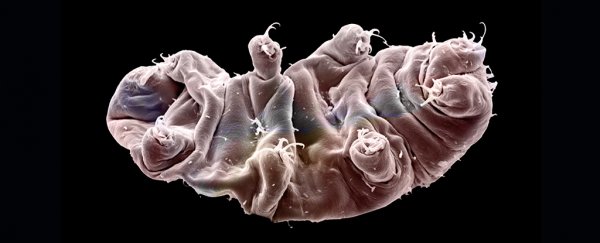A team of physicists claims to have entangled a superconducting qubit and a tardigrade, moving the freezing, tiny, and well-controlled world of quantum into the "hot and wet" systems of life.
However, the results described in this preprint paper are not quite so cut and dried, and many quantum researchers are arguing that the poor tardigrade wasn't entangled in a meaningful way.
"I also don't know how [serious] the authors were about this – it could be a tongue-in-cheek piece," writes Rice University physics professor Douglas Natelson.
"That said, it's important to point out that the authors did not entangle a tardigrade with a qubit in any meaningful sense. This is not 'quantum biology'."
Quantum entanglement is when two or more particles are linked in such a way that a fundamental quality they share – such as position, momentum, or polarization – are not independent of each other.
To take a simple non-quantum example, if you found a right-handed glove in your drawer, you could be certain the missing glove would fit your left hand: knowing something about one tells you something important about the other, and that information is not random.
Entanglement happens in quantum systems naturally after particle collisions, or almost any other time particles interact. Although Albert Einstein wasn't much of a fan, physicists have shown in the years since that entanglement itself isn't super hard to produce.
Scientists have done pretty well entangling larger and larger things. They've entangled molecular ions, larger nanoparticles, and even teeny tiny diamonds.
But all of those systems are still extremely small, usually very cold, and well organized. A tardigrade by contrast – even in its dehydrated, 'indestructible' state – is a comparatively large collection of frozen, messy biological molecules.
In this new preprint paper made available on arXiv, the researchers took a tardigrade species called Ramazzottius varieornatus, and placed it into a dehydrated cryptobiosis. They then cooled it down to just 10 millikelvin over absolute zero, and put it under extremely low pressure of just 0.000006 millibars.
Then, the team ran experiments where they attempted to entangle the tardigrade with two superconducting transmon qubits, finding that they "observed coupling" between the creature and the qubits.
After about 420 hours of experiments, they heated up the tardigrade, and it went along its merry way.
But after some initial breathless headlines, a number of physicists and science writers are pointing out that this is not really entanglement – or at least not something that hasn't been done before.
"The qubit is an electrical circuit and putting the tardigrade next to it affects it through the laws of electromagnetism we've known about for more than 150 years," physicist and science writer Ben Brubaker writes on Twitter.
"Putting a speck of dust next to the qubit would have a similar effect."
So, this is not really an entangled tardigrade in any quantum sense of the word. In fact, according to which physicist you ask, it's either a classical (non-quantum) interaction between a qubit and a tardigrade, or there was no evidence of interaction at all and they merely put a very cold, very low-pressure tardigrade on a qubit.
The authors of the new work do note this is a new record "for the conditions that a complex form of life can survive," which is possibly the most interesting part of this new study. However, we'll need to wait for peer review to see these claims verified.
For now, it doesn't appear we have enough evidence for the first living organism to have been quantum entangled, as exciting as the idea of a quantum tardigrade may sound.
We also don't really know how seriously we should be taking this research, and whether the researchers knew their work would get quite as much scrutiny as it now has.
"I did wonder about the timing of this preprint being uploaded and sent out to the wider world," says Tara Roberson, researcher at the Australian Research Council Centre of Excellence for Engineered Quantum Systems who specializes in science communication and 'hype'.
"Generally speaking, if you want something complex and dense – academically-intense – to be read, you don't put it up in December. But if you're uploading something a bit silly and easy for audiences … then now is certainly the time!"
"I don't know if that was part of the research team's thought process, but certainly the idea of an entangled tardigrade made me laugh."
The paper is available on the preprint server arXiv.
